Das Training läuft! Recht gut sogar. Ich konnte die Umfänge in den letzten beiden Wochen auf ca. 70 Kilometer/Woche hochfahren. Dabei verfolge ich meinen Plan, dass die Einheiten einerseits auf die Entwicklung des Schwellentempos und andererseits auf die Langzeitausdauer ausgerichtet sind. Doch ich spüre: jetzt beginnt die Zeit, wo es nicht mehr bei jeder Einheit "wie von selbst" läuft, wo die Anfangseuphorie langsam dem Trainingsalltag weicht, wo sich zunehmend Müdigkeit durch die erhöhte Belastung einstellt und man sich manchmal einfach nur selbst in den Hintern treten muss. Kurz: der Kampf gegen sich selbst. I love it! Challenge accepted!
Mein Trainingsrevier: im Berliner Grunewald absolviere ich die meisten der Laufeinheiten.
Ich liege so weit gut im Plan. Die Wochenkilometer sind momentan noch auf vier Laufeinheiten aufgeteilt, die "längeren" Läufe habe ich mittlerweile auf 25 Kilometer ausgedehnt, Tendenz weiter steigend. Auf der anderen Seite stehen bei mir vor allem Intervall- und Tempowechselläufe in den vorgesehenen Trainingsbereichen im Vordergrund. In der kommenden Woche gehe ich dann auf fünf Einheiten hoch, bevor es in eine Entlastungswoche geht. Neben der reinen Planung der einzelnen Lauftrainings mache ich mir jetzt immer mehr Gedanken zur Regenerationsfähigkeit. Mit zunehmenden Umfängen werden die Erholungsphasen zwischen den Einheiten immer kürzer und es wird nun immer entscheidender, die Trainingseinheiten besser nachzubereiten, um den Körper wieder für die nächste schnelle Einheit fit zu machen.
Train - Eat - Sleep
Wie so oft macht der Körper erstmal den ganzen Kram mit, meldet sich dann aber, wenn es ihm zu stressig wird. Jetzt gilt es aber, diese Signale zu interpretieren. Ziemlich einfach ist dieses Signal: wenn Du nachts mit einem Wadenkrampf aus dem Schlaf gerissen wirst, weißt Du - zu wenig getrunken, mehr dehnen! Die anfänglich kurzen Dehnprogramme nach dem Laufen habe ich deutlich ausgedehnt (Achtung Wortspiel) und verbringe nun zusätzlich drei Extra-Einheiten pro Woche nur auf der Matte (30-60 min), um Hüftbeuger, Wade & Co. wieder aufzulockern. Zusätzlich kommt auch gern gern ein Foltergerät namens Blackroll zum Einsatz. Diese "muskuläre Nachbereitung" halte ich für extrem wichtig und einen Schlüsselaspekt bei der Regeneration. Nicht nur, um Krämpfe zu vermeiden, sondern für eine insgesamt bessere Erholungsfähigkeit (Vermeidung eines konstant hohen Muskeltonus, verbesserte Durchblutung, Sauerstoffzufuhr, Abtransport von Stoffwechselprodukten). Die Beine sind am nächsten Tag gefühlt deutlich lockerer als die "festen Klumpen" vom Vortag.
Dennoch merke ich, dass ich kaum noch komplett frisch in das nächste Training gehe, da sich die Belastung ja bereits über mehrere Wochen zunehmend gesteigert hat. Die wichtigsten Instrumente zur Erholung sind Essen und Schlaf. Tja, wie im Trainingslager - nur, dass eben noch ein bisschen "Arbeit und Alltag" dazwischen kommt. Aber das ist halt normal, man muss sich arrangieren. Schließlich ist das Laufen ein privilegiertes Hobby in diesen Zeiten, ich möchte mich nicht beschweren. Ich richte mich momentan nach keiner bestimmten Diät oder Ernährungsformel, esse mehr oder weniger alles, was der Kühlschrank hergibt, aber dennoch bewußt abwechslungsreich. Ich verzichte auch (noch) nicht auf kleine Leckerlis - mein Gewissen kann sich noch gut damit arrangieren. Bei meiner letzten Marathonvorbereitung 2009 habe ich zwei Wochen vor dem Wettkampf eine Saltin-Diät gemacht. Das ist eine extreme Form des Carbo-Loadings, bei der die Speicher eine Woche lang durch fast kohlenhydratlose Kost bei moderatem Training entleert werden, um sich dann wenige Tage vor dem Wettkampf mit Kohlenhydraten vollzuhauen und dadurch eine signifikante Erhöhung der Speicher zu erreichen. Für die Saltin-Diät gibt es in der Sport- und Ernährungswissenschaft Pro und Kontra, bei mir hat sie das letzte Mal gut funktioniert - ich hatte das Gefühl, im Rennen länger auf hohem Niveau laufen zu können. Momentan tendiere ich dazu, sie auch dieses Mal in der unmittelbaren Vorbereitung wieder durchzuführen. Bis dahin sind es aber noch viele viele Kilometer... Also, ich muss los - bis zum nächsten Mal.





















1 Kommentar
JCB
Liest sich sehr spannend und enthält wichtige Tipps für andere Läufer – super!